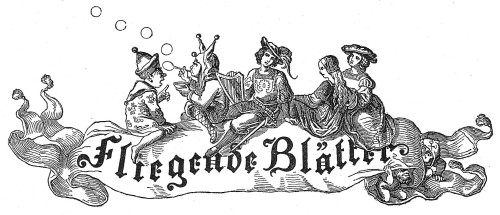On my continuing search for information on Friedrich Wahle, I found one auction description that mentioned he worked for Fliegende Blätter. Fliegende Blätter translates to “Flying Leaves” and was a prominent German journal of “humor and wit”. The paper was founded in 1845 shortly after Punch, the British satirical paper. It published weekly out of Munich until 1944. The journal was filled with comics, poems and short stories. Most of the available information about the journal is in German (which is becoming quite the trend with this research project). One reviewer notes that Fliegende Blätter was known for “unerring satirical characterization of the German bourgeoisie” and “a compendium of humorous social criticism”. (Or at least that’s what Google Translate tells me.) I found a contemporary essay about Fliegende Blätter (circa 1894) [1]:
Its humor is thus spontaneous, natural, and universal. Its contributors are found in every rank – men and women, rich and poor, young and old. None is too wise and no too lowly to send the joke of the day to this paper.
Thankfully the Heidelberg University Library has the entire 100 year run digitized and online so I have been flipping through some issues, focusing mainly on years which Wahle was probably active. The illustrations are fantastic! The journal is approximately half text and half drawings which range from little comical sketches to full page paintings. The art definitely gets larger and more elaborate as the years progress. The images mostly feature daily life focusing on people presumably involved in the corresponding stories, with a few fantasy images thrown in as well. I am recognizing the artists from issue to issue so at least there was a set of professional illustrators that worked for the journal.
I’ve noticed that Emil Reinicke draws humorous, folksy caricatures of everyday people. The scenes and situations depicted are a little goofy but expertly drawn in a stylized way. Although I’m unsure of the spelling of his name, H. Soblittgen contributes some great ink drawings of society life.
One of the most skilled and most frequently featured artist appears to be René Reinicke. I’m not sure if he’s related to Emil above, but given his lifespan (1860-1926), R. Reinicke would have been a contemporary of Wahle. In some sources he is listed as a primary Fliegende Blätter artist. His style is similar to Wahle’s but subject matter tends to be very grand. R. Reinicke paints formal balls and outdoor scenes with everyone wearing the height of fashion.
Having gone through a few random years, I have seen about 40 Wahle paintings. On average, he was publishing 18 paintings a year in Fliegende Blätter but it was variable. Sometimes there are 4-6 paintings in one month followed by a 4month absence. I remain impressed with the quality and variety of his works.
Of course, my focus right now in going through issues of Fliegende Blätter is to find and catalog Wahle’s works. Regardless, I’m already noticing how the journal’s illustrations evolved over decades and were influenced by the Art Nouveau movement. There are some reoccurring characters (including one drawn by Wahle) that I’ll have to do a little more research on. I’m also curious to see how this comic, sometimes whimsical, journal handles World War I and II given that it published straight through to 1944. At the very least, I am definitely on the right track for understanding Friedrich Wahle’s style and putting together his portfolio. Who knows, The Discourse may be in one of these issues!
Reference:
[1] “A German Comic Paper (Fliegende Blätter)” by William DeLancy Ellwanger and C. M. Robinson, 1894, published unknown (access from Univ. of Toronto collection)
Filed under: Art, Art History, History, The Friedrich Wahle Project Tagged: 19th century, art, art history, Friedrich Wahle, Germany, history, humor, illustration, research






